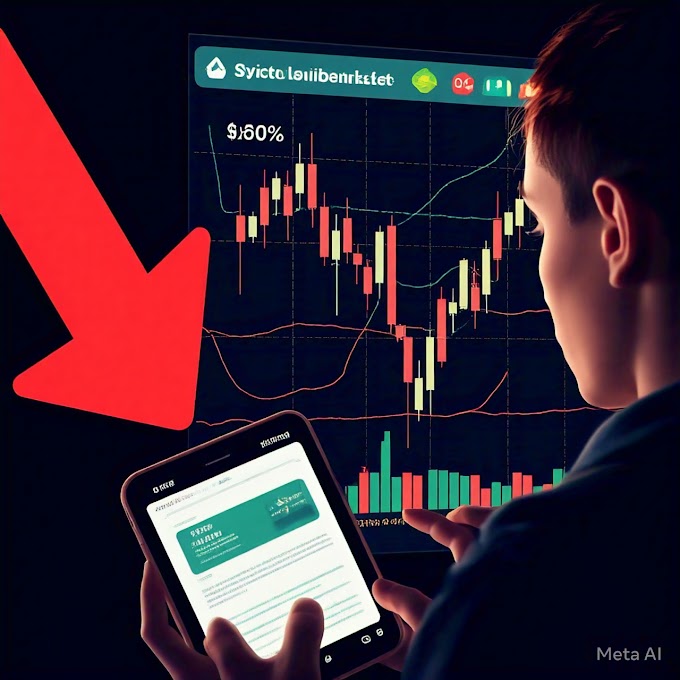Cryptocurrency trading can feel like navigating a stormy sea—exciting, unpredictable, and sometimes overwhelming. Knowing when to buy and sell crypto is a skill that combines research, strategy, and a bit of intuition. Unlike traditional markets, crypto operates 24/7, with prices swinging wildly based on news, trends, and global events. Whether you're a beginner or a seasoned trader, understanding the right moments to enter or exit the market can make all the difference. This article breaks down the essentials of timing your crypto trades, offering practical insights to help you make informed decisions without falling into common traps.
Table of Contents
- Understanding Market Cycles
- Technical Analysis Basics
- Fundamental Analysis for Crypto
- Sentiment Analysis and Market Psychology
- Risk Management Strategies
- Timing Tools and Indicators
- Common Mistakes to Avoid
- FAQs
- Conclusion
1. Understanding Market Cycles
Cryptocurrency markets move in cycles, much like traditional financial markets, but with amplified volatility. These cycles typically include four phases: accumulation, uptrend (bull market), distribution, and downtrend (bear market). Recognizing where the market stands can guide your buying and selling decisions.
During the accumulation phase, prices are low, and savvy investors quietly buy up assets while the market is undervalued. This is often a good time to buy, as prices are stable but poised for growth. The uptrend follows, where enthusiasm drives prices higher—sometimes exponentially. Selling during the peak of a bull market can maximize profits, but timing the top is tricky. The distribution phase sees early sellers cashing out, often signaling a shift. Finally, the downtrend brings falling prices, where panic selling dominates. Buying during a bear market can be a bargain, but it requires confidence in the asset’s long-term value.
To spot these cycles, track historical price data and market cap trends using platforms like CoinMarketCap or CoinGecko. For example, Bitcoin’s halving events (occurring roughly every four years) often spark bull runs, as reduced supply meets rising demand. Studying past cycles, like Bitcoin’s 2017 or 2021 surges, can help you anticipate future patterns.
2. Technical Analysis Basics
Technical analysis (TA) involves studying price charts and patterns to predict future movements. While it’s not foolproof, TA provides a structured way to assess market trends. Key tools include:
Support and Resistance Levels: Support is a price level where buying interest typically prevents further drops, making it a potential buying opportunity. Resistance is where selling pressure halts price increases, signaling a possible time to sell. Identify these levels by looking at historical price points where the market consistently reverses.
Moving Averages: The 50-day and 200-day moving averages smooth out price data to show trends. A “golden cross” (when the 50-day crosses above the 200-day) suggests a buying opportunity, while a “death cross” (the opposite) may indicate a time to sell.
Relative Strength Index (RSI): RSI measures momentum on a scale of 0 to 100. An RSI above 70 indicates an overbought asset (potential sell signal), while below 30 suggests oversold conditions (potential buy signal).
Candlestick Patterns: Patterns like “doji” or “hammer” can hint at reversals or continuations. For instance, a bullish engulfing pattern often signals a buying opportunity after a downtrend.
Start with free charting tools like TradingView to practice spotting these patterns. Focus on major coins like Bitcoin or Ethereum, as their higher liquidity makes TA more reliable.
3. Fundamental Analysis for Crypto
Fundamental analysis (FA) evaluates a cryptocurrency’s intrinsic value based on its technology, team, and market potential. Unlike TA, which focuses on price action, FA digs into the “why” behind a coin’s value. Key factors include:
Whitepaper and Roadmap: A strong whitepaper outlines a project’s purpose and technology. Check if the team delivers on its roadmap—delays or vague goals are red flags.
Team and Community: Research the developers and advisors. A transparent team with a track record (e.g., Ethereum’s Vitalik Buterin) adds credibility. Active communities on platforms like Discord or X also signal strong support.
Use Case and Adoption: Does the crypto solve a real problem? For example, Chainlink’s oracle network enables smart contracts to interact with real-world data, driving its adoption. Projects with growing partnerships or real-world use are often safer bets.
Tokenomics: Analyze the coin’s supply and distribution. A limited supply (like Bitcoin’s 21 million cap) can drive value, while excessive inflation dilutes it. Check if tokens are locked or vesting to avoid sudden dumps.
Buy when a project shows strong fundamentals but is undervalued—often during early development or market dips. Sell if fundamentals weaken, like missed deadlines or regulatory crackdowns.
4. Sentiment Analysis and Market Psychology
Crypto markets are heavily influenced by human emotions—greed, fear, and hype. Sentiment analysis gauges the crowd’s mood to predict price movements. Tools like X posts, Google Trends, or sentiment trackers (e.g., The TIE) can reveal whether investors are bullish or bearish.
Fear and Greed Index: This index combines market data like volatility and social media activity. Extreme fear (low index) often signals a buying opportunity, as panic oversells assets. Extreme greed (high index) suggests a potential sell, as euphoria inflates prices.
News and Events: Major news, like Elon Musk’s tweets or regulatory announcements, can swing markets. For example, China’s 2021 crypto ban triggered a crash, while ETF approvals sparked rallies. Stay updated via CoinDesk or CoinTelegraph, but verify X posts for real-time sentiment.
FOMO and FUD: Fear of missing out (FOMO) drives impulsive buying during pumps, often leading to losses. Fear, uncertainty, and doubt (FUD) can cause panic selling. Counter these by sticking to your strategy, not the crowd’s emotions.
Buy when sentiment is overly pessimistic but fundamentals remain strong. Sell when hype peaks, especially if prices outpace a coin’s actual progress.
5. Risk Management Strategies
No matter how skilled you are, crypto’s volatility demands risk management. Protect your capital with these strategies:
Position Sizing: Never invest more than you can afford to lose. A common rule is to allocate 1-5% of your portfolio per trade to limit losses.
Stop-Loss Orders: Set stop-losses to automatically sell if a price drops below a threshold. For example, if you buy Ethereum at $3,000, a 10% stop-loss at $2,700 caps your loss.
Diversification: Spread investments across multiple coins to reduce risk. Avoid putting all your money into one volatile altcoin.
Take Profits Gradually: Instead of selling everything at once, scale out during uptrends. For instance, sell 25% of your holdings at a 50% gain, another 25% at 100%, and so on.
Dollar-Cost Averaging (DCA): Buy fixed amounts regularly (e.g., $100 monthly) to smooth out price volatility. This works well for long-term investments like Bitcoin.
Always have an exit plan before entering a trade. Decide your target profit and loss limits to avoid emotional decisions.
6. Timing Tools and Indicators
Several tools can help time your trades beyond TA and FA:
On-Chain Analytics: Platforms like Glassnode or CryptoQuant track blockchain data, like wallet activity or exchange inflows. Large inflows to exchanges often signal selling pressure, while outflows suggest holding (a buy signal).
Volume Analysis: High trading volume confirms trends. A price breakout with low volume is less reliable, so wait for confirmation before buying or selling.
Funding Rates: In futures markets, funding rates show whether longs or shorts dominate. High positive rates (longs paying shorts) may indicate an overheated market, signaling a sell.
Calendar Events: Track events like protocol upgrades or token unlocks. For example, Ethereum’s Merge in 2022 boosted prices, while token unlocks can cause dumps.
Combine these tools for better accuracy. For instance, if on-chain data shows accumulation and RSI indicates oversold conditions, it’s likely a good time to buy.
7. Common Mistakes to Avoid
Crypto trading is a minefield of pitfalls. Avoid these common errors:
Chasing Hype: Buying during parabolic rises (e.g., Dogecoin’s 2021 spike) often leads to buying at the top. Wait for pullbacks instead.
Ignoring Fees: High trading or gas fees (especially on Ethereum) can eat into profits. Use layer-2 solutions or trade during low network congestion.
Overleveraging: Using borrowed funds amplifies gains but also losses. Stick to spot trading unless you’re experienced.
Neglecting Security: Store crypto in hardware wallets (e.g., Ledger) or secure exchanges. Never leave large sums on hot wallets.
Emotional Trading: Panic-selling during dips or FOMO-buying during pumps kills profits. Follow your plan, not your emotions.
Learn from others’ mistakes by engaging with crypto communities on X or Reddit, but always verify advice.
8. FAQs
Q: Should I buy crypto during a dip?
A: Dips can be great buying opportunities if the asset’s fundamentals are strong. Use TA (e.g., RSI) and on-chain data to confirm the dip isn’t part of a larger downtrend.
Q: How do I know when a bull run is starting?
A: Look for signs like increasing trading volume, bullish TA patterns (e.g., golden cross), and positive news (e.g., ETF approvals). On-chain metrics like reduced exchange balances also hint at accumulation.
Q: Is day trading crypto a good idea?
A: Day trading is risky due to crypto’s volatility and fees. It suits experienced traders with strong TA skills. For beginners, long-term holding or DCA is safer.
Q: How much should I invest in crypto?
A: Only invest what you can afford to lose. A common rule is 1-10% of your portfolio, depending on your risk tolerance.
Q: Can I trust crypto influencers on X?
A: Some influencers share valuable insights, but many push agendas or shill coins. Cross-check their claims with data from CoinMarketCap, Glassnode, or reputable news sources.
9. Conclusion
Knowing when to buy and sell crypto requires a blend of market knowledge, analytical tools, and disciplined execution. By understanding market cycles, mastering technical and fundamental analysis, gauging sentiment, and managing risks, you can make smarter trading decisions. Tools like on-chain analytics and volume indicators add precision, while avoiding common mistakes keeps you grounded. Crypto’s wild swings can be intimidating, but with patience and strategy, you can navigate the market confidently. Stay informed, stick to your plan, and always prioritize security to thrive in this dynamic space.


.png)
.png)
.png)





